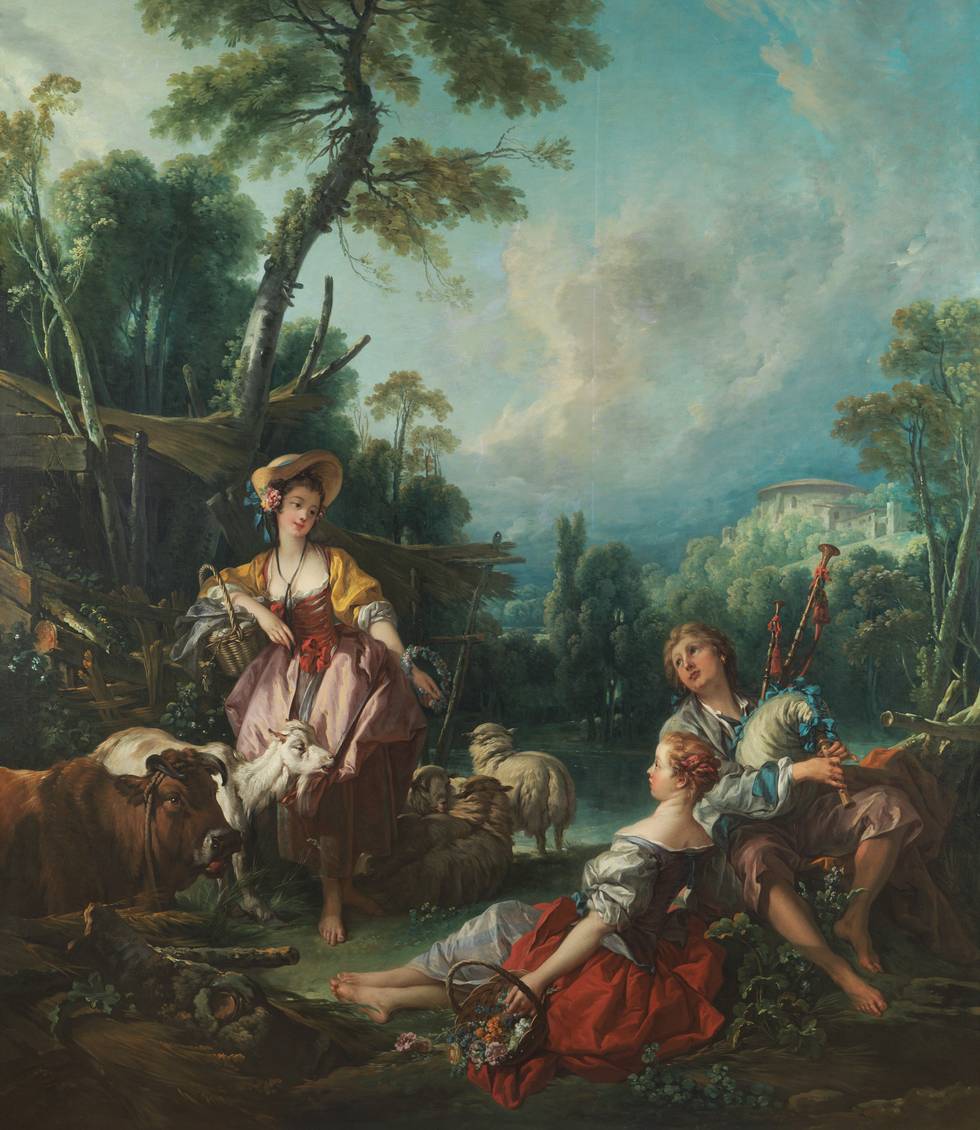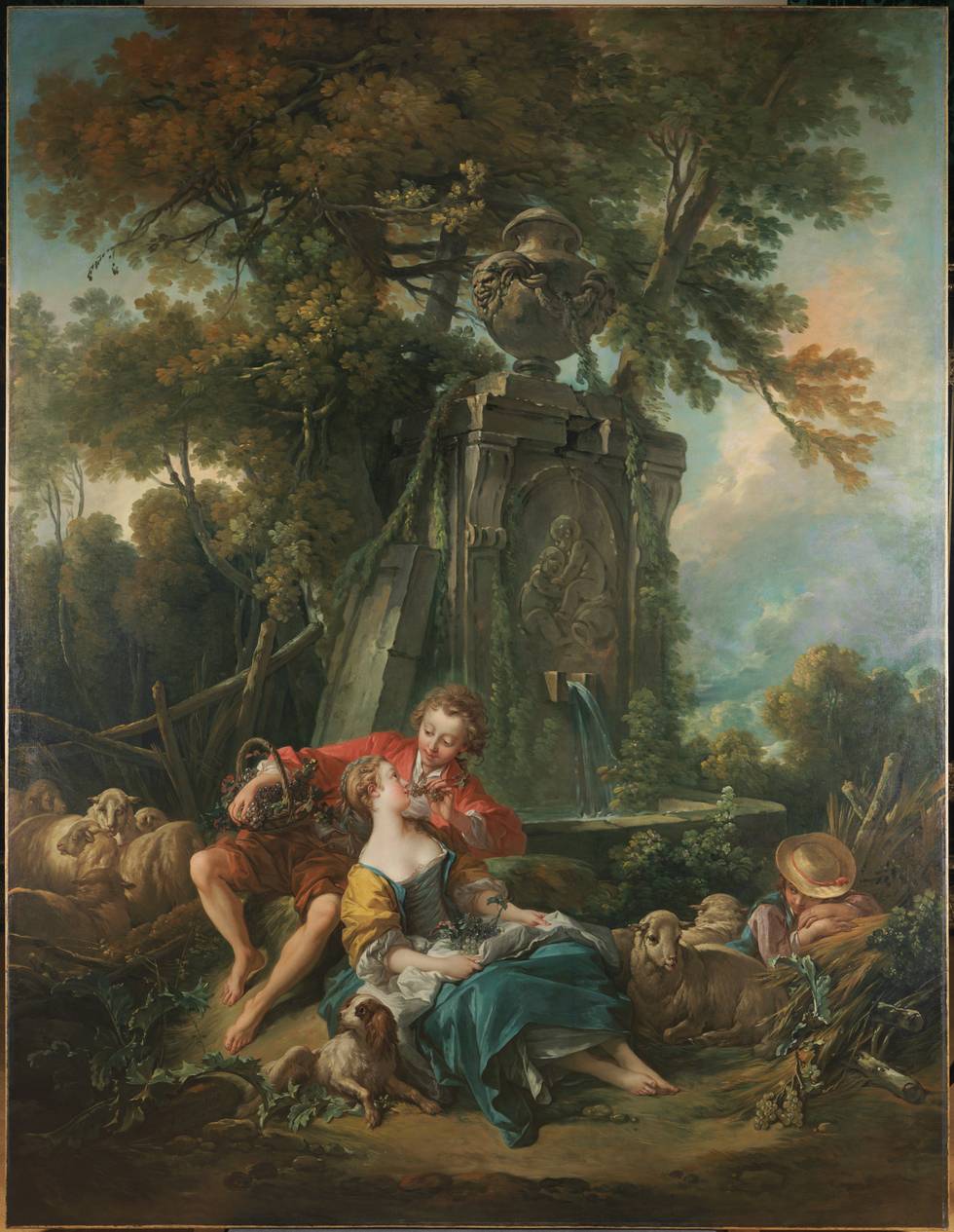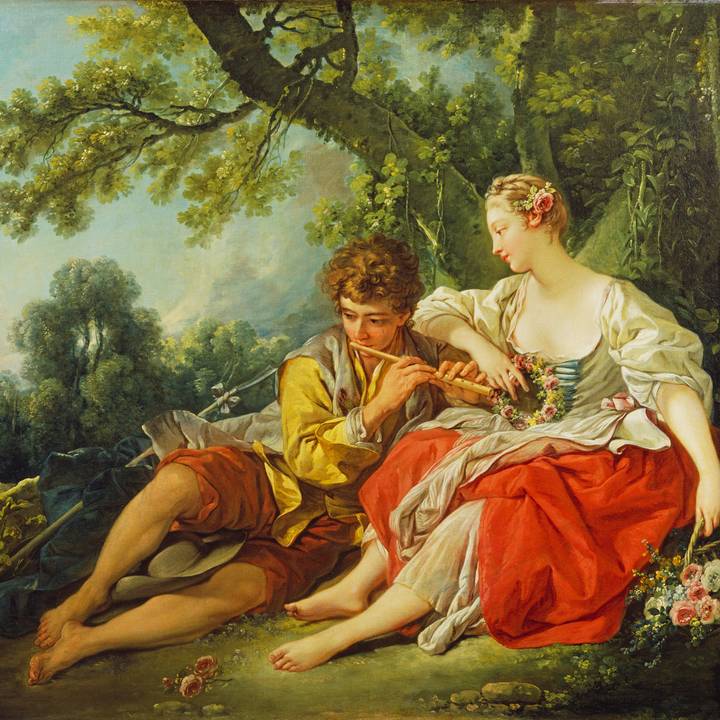Date: 1749
Materials: Oil on canvas
Measurements: 259 x 197 cm
Inv. Nos: P489 and P482
These two paintings exemplify some of Francois Boucher’s (1703-1770) most ambitious works in the pastoral style, continuing Antoine Watteau's (1684-1721) tradition of idyllic scenes but shifting them to an idealised Italian setting.
By replacing Watteau’s contemporary Parisians with shepherds and shepherdesses, Boucher transported the scenes into a purely imaginary world, detached from recognisable reality. Unlike Watteau’s smaller, cabinet-sized pieces, Boucher often created large-scale decorations for entire rooms, as seen in these works.
Originally, these paintings belonged to Daniel-Charles Trudaine (1703-1769), the governor of Auvergne and later an overseer of France's roads and bridges, who played a pivotal role in expanding and modernizing the French road network. In 1745, he also began and directed the production of a new national atlas.
Trudaine displayed the paintings in the grand salon of his country estate at Montigny-Lencoup near Fontainebleau.
In 1818, when Comte George de Stacpoole acquired the château, the paintings were considered integral to its decor and thus passed into his possession, eventually inherited by his son, Richard. They were later sold to Lord Hertford for a modest 12,400 francs (approximately £496).
Boucher has often been narrowly characterised for his superficial prettiness. Denis Diderot (1713-1770), along with the younger generation of French Revolutionaries, criticized his later work for "simperings, affectations… the degradation of taste,". Even sympathetic critics like the Goncourt brothers praised him with ambivalence, describing him as an "original, highly gifted painter" but lacking the distinction that marks the greats, concluding that "elegant vulgarity—that is the hallmark of Boucher."
This somewhat dismissive view of Boucher persists in recent criticism, yet do these paintings support such claims? While they possess undeniable prettiness, they offer far more than superficial charm.
The animated figures are not just marionettes; they engage in specific, deliberate actions deeply intertwined with their surroundings, elevating them beyond mere decoration.
Viewers were never meant to believe that rural girls would actually wear satin gowns or tie sheep with blue silk ribbons. This was a world where lords and ladies dressed down for courtly entertainment, where a lady could express romantic inclinations by dressing as a shepherdess, and where the phrase "l’heure du berger" (the shepherd’s hour) was understood as the time for romance.
Yet this was also a society that elevated the art of human relationships—whether in conversation, letter-writing, music, dancing, or courtship. For such a sophisticated audience, the narrative intricacy in Boucher’s paintings was central to their appeal; the playful irony of these scenes is integral to their aesthetic power and effect.
The theatre also provides valuable context for Boucher’s choice of subject matter. He designed sets, costumes, and backdrops for the Opéra Comique and other theaters, where he learned to appeal to audiences who frequented these spirited productions.
According to theater historians Claude and François Parfaict, "Monsieur Boucher, the Painter famous for his graceful compositions, borrowed the idea for several of his pictures" from a pantomime called The Vintages of Tempe, first performed by Boucher's friend Charles Simon Favart (1710-1792) in 1745. Boucher’s use of this source was typically subtle, adding thematic nuance without direct illustration.
Both of these paintings are set in an Arcadian landscape where abundant, flourishing nature—vines, creepers, and flowers—contrasts with ruins from a classical past, visible in the background. The figures seem at home in this lush, timeless world of Arcadia; they are its native citizens.

In Pastoral with a Bagpipe Player, innocence is the apparent theme. A shepherd serenades his beloved, Lisette, on bagpipes adorned with ribbons as he stands before a rustic structure surrounded by animals.
Behind them, a rich valley sweeps toward mountains crowned with an Italian villa. The floral crown Lisette holds shows she has accepted his affection, even though the couple stands apart without overt intimacy.
Yet Boucher infuses a delicate hint of hidden passion: a goat, often symbolizing sexual desire, gazes pointedly at the shepherd while standing close to Lisette.

Pastoral with a Couple near a Fountain offers a similar inversion of expectations. The two figures recline gently at the forefront, gazing into each other’s eyes as another figure looks on coyly. Their elegance contrasts with the untamed woods around them, giving the scene a languid quality.
At first glance, Boucher presents innocence and delicacy, yet subtle details suggest a deeper layer. The shepherdess’s small dog—a common emblem of fidelity, famously used by Madame de Pompadour under Boucher's guidance—turns away from the couple, offering them privacy.
Above them, an urn decorated with a ram’s head and vines hints at a wilder, more sensual undercurrent, aligning with the carpe diem theme so popular in 18th-century France. This notion of seizing life’s fleeting pleasures heightens the awareness of youth and beauty as transient, even more so than any enduring classical statue.



